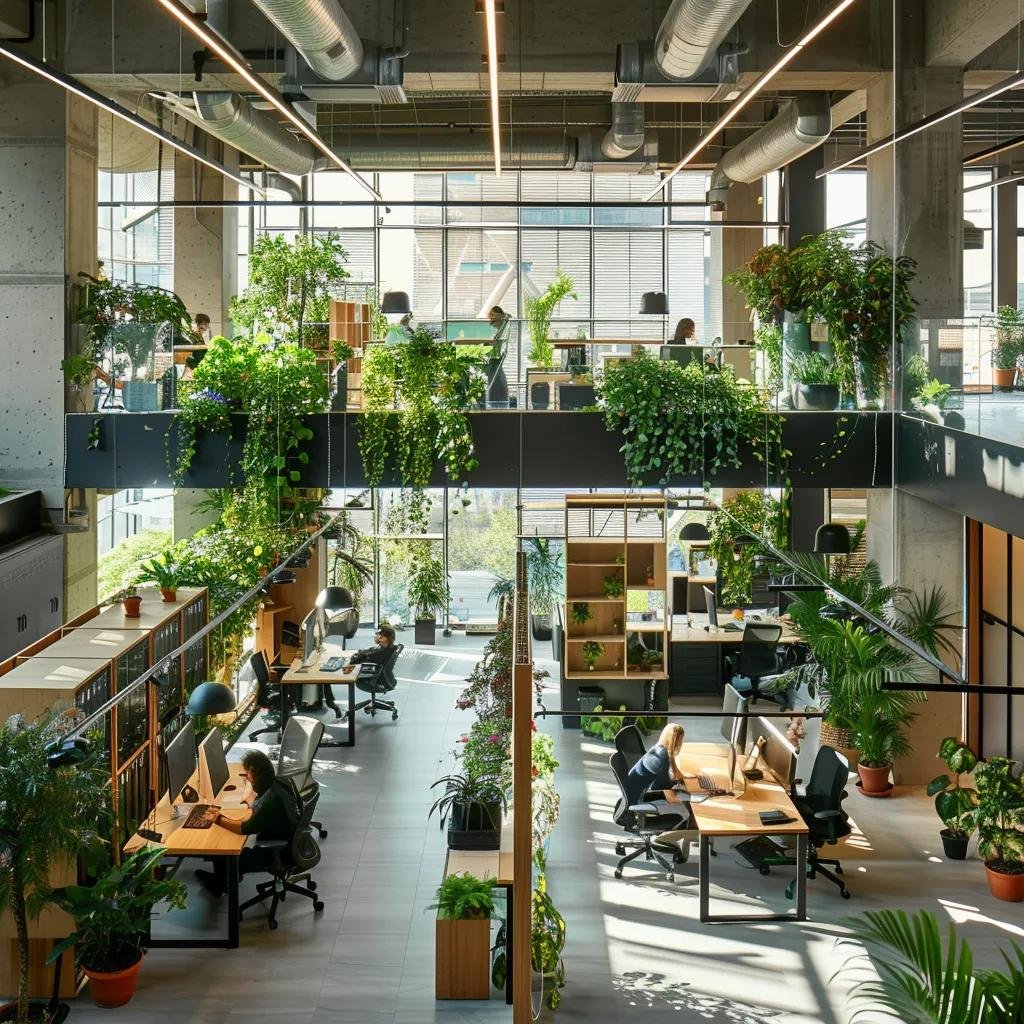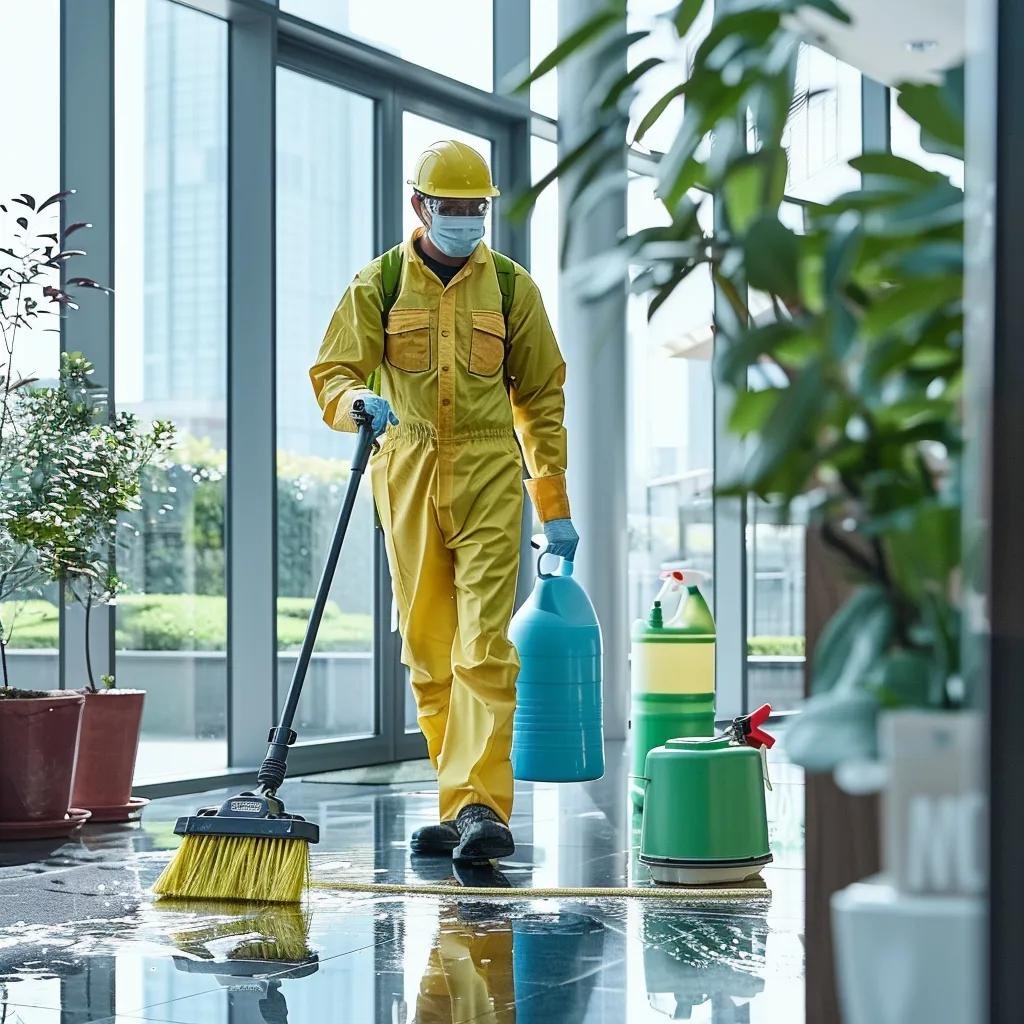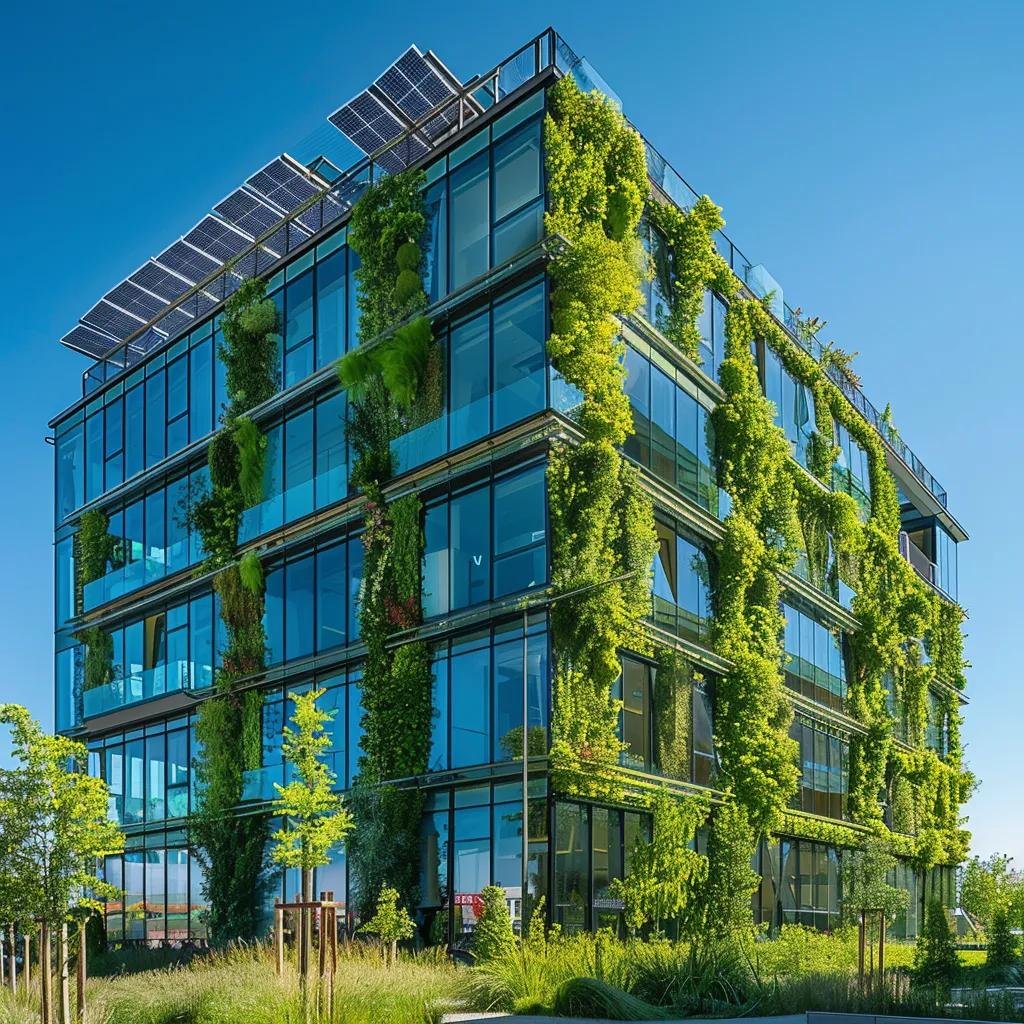Sustainable Practices in Commercial Building: Transforming Construction Today for Health, Efficiency, and Certification
Commercial buildings generate 33 percent of global greenhouse gas emissions and consume 40 percent of energy, making sustainable practices in commercial building essential for environmental and economic performance. This article explains how green construction enhances energy efficiency, occupant health, and regulatory compliance, and shows how eco-friendly commercial cleaning and sustainable air duct cleaning services—from companies like Mastodon Marketing—support long-term building sustainability. You will learn:
- Key benefits of sustainable commercial construction
- The impact of indoor air quality (IAQ) and how ventilation, HEPA filtration, and low-VOC materials contribute
- LEED certification requirements for sustainable cleaning and how green cleaning products and custodial effectiveness earn credits
- Advantages of eco-friendly commercial cleaning services on IAQ, health, and environmental goals
- Why sustainable air duct cleaning is vital for HVAC energy efficiency and IAQ
- Current challenges in sustainable construction and innovative solutions
- Future trends: smart buildings, circular economy materials, and evolving certification standards
Transforming Commercial Buildings Through Sustainable Practices
Sustainable practices in commercial construction integrate resource efficiency, renewable energy, and eco-friendly materials to reduce operating costs, enhance energy performance, and improve occupant health. By optimizing envelope design, leveraging recyclable materials, and integrating on-site renewables, green buildings deliver measurable savings and brand value.
How Do Sustainable Practices Reduce Costs and Improve Energy Efficiency?
Sustainable buildings lower utility expenses by improving insulation, optimizing daylighting, and incorporating energy-efficient systems such as LED lighting and high-performance glazing.
- Envelope Optimization: Advanced insulation and reflective roofing reduce heating and cooling loads.
- Efficient HVAC: Variable-speed drives and heat-recovery systems cut energy consumption.
- Renewable Integration: Solar PV and geothermal systems offset grid usage.
These measures deliver up to 30 percent energy savings annually, preparing facilities for certification frameworks and lowering life-cycle costs for building owners.
Energy Savings in Green Buildings
Sustainable buildings can significantly reduce energy consumption through various strategies. These include optimizing building envelope design, incorporating efficient HVAC systems, and integrating renewable energy sources like solar photovoltaic (PV) and geothermal systems. These measures can lead to substantial annual energy savings, preparing facilities for certification and lowering life-cycle costs.
In What Ways Do Green Buildings Enhance Corporate Image and Occupant Health?
Green buildings promote a positive brand reputation and tenant satisfaction by showcasing environmental responsibility and providing healthier indoor environments.
- Biophilic Design: Natural materials and greenery boost well-being.
- Daylight Access: Improves mood, circadian rhythms, and productivity.
- Low-VOC Materials: Reduce chemical exposure, minimizing headaches and respiratory issues.
Enhanced occupant comfort and sustainability awards foster stakeholder trust and can command higher lease rates.
How Does Sustainable Construction Support Regulatory Compliance and LEED Certification?
Sustainable commercial construction aligns with evolving building codes and standards, streamlining approval and incentives. By meeting LEED credits for energy performance, water efficiency, and materials sourcing, projects access tax rebates, grants, and accelerated permitting.
| Entity | Attribute | Value |
|---|---|---|
| Envelope Design | Energy Savings | Up to 30 percent reduction in HVAC load |
| Renewable Energy Systems | On-site Generation | Solar PV offsets 10–20 percent demand |
| LEED Certification Requirements | Credits Achieved | Energy & Atmosphere, Water Efficiency |
These integrated practices minimize regulatory hurdles while securing LEED Silver, Gold, or Platinum levels for commercial projects.
How Does Indoor Air Quality Impact Sustainable Commercial Buildings?

Indoor air quality (IAQ) is central to sustainable construction because polluted air undermines occupant health and building performance. Proper ventilation, material selection, and filtration systems form the backbone of IAQ strategies that align with green building standards.
Indoor Air Quality and Occupant Health
Indoor air quality (IAQ) is crucial in sustainable construction, as polluted air can negatively impact occupant health and building performance. Effective ventilation, the use of low-VOC materials, and filtration systems are essential for maintaining good IAQ. Studies show that improved IAQ can enhance cognitive function and productivity in the workplace.
What Role Do Ventilation Systems and Low-VOC Materials Play in IAQ?
- Mechanical Ventilation supports continuous air exchange per ASHRAE standards.
- Demand-Controlled Ventilation adjusts airflow based on occupancy sensors.
- Low-VOC Materials maintain contaminant levels below recommended thresholds.
Integrating these elements ensures compliance with LEED Indoor Environmental Quality credits and elevates air quality metrics.
How Do HEPA Filtration and Moisture Control Improve Building Health?
HEPA filters capture 99.97 percent of airborne particles ≥0.3 microns, preventing allergens and pathogens from circulating. Moisture control through vapor barriers and dehumidification limits mold growth.
| Entity | Attribute | Value |
|---|---|---|
| HEPA Filtration | Particle Removal | 99.97 percent @ 0.3 microns |
| Moisture Control | Relative Humidity | Maintained at 30–50 percent to inhibit mold |
Why Is IAQ Critical for Occupant Well-Being and Productivity?
High IAQ enhances cognitive function, reduces sick-building symptoms, and supports overall productivity. Studies show a 10 percent increase in decision-making performance in environments with optimal air quality. Improved ventilation and filtration translate directly into healthier, more effective workplaces.
What Are LEED Certification Requirements for Sustainable Commercial Cleaning?
LEED Certification and Sustainable Cleaning
Achieving LEED O+M credits for sustainable cleaning requires documented policies, staff training, and the use of certified products. Green Seal or EcoLogo certifications verify that cleaning agents meet strict criteria for biodegradability, low toxicity, and minimal VOC content. Regular audits and documented cleaning logs validate performance and support continuous LEED certification renewal.
How Do LEED O+M Credits Relate to Cleaning Practices?
LEED Operations & Maintenance awards points for executive green cleaning policies, occupant education, and custodial staff training. Points are earned by:
- Developing a Green Cleaning Plan that prioritizes sustainability.
- Training Custodial Staff on low-impact procedures.
- Monitoring Outcomes through audits and IAQ testing.
What Are the Standards for Green Cleaning Products and Equipment?
Green Seal or EcoLogo certifications verify that cleaning agents meet strict criteria for biodegradability, low toxicity, and minimal VOC content. Equipment standards favor microfiber cloths and HEPA-filtered vacuums to trap fine particulates.
- Certified Products use plant-based surfactants and no harmful solvents.
- Microfiber Technology removes up to 99 percent of bacteria from surfaces.
- HEPA-Vacuum Systems prevent re-release of dust into the air.
How Does Custodial Effectiveness Influence LEED Compliance?
Custodial effectiveness—measured by surface cleanliness and IAQ improvements—directly impacts O+M credit retention. Regular audits and documented cleaning logs validate performance and support continuous LEED certification renewal.
How Do Eco-Friendly Commercial Cleaning Services Support Sustainable Construction?

What Are the Benefits of Using Non-Toxic and Green Seal Certified Cleaning Agents?
Non-toxic, biodegradable cleaners safely remove soils without harmful residues, protecting sensitive finishes and occupant health.
- Reduced Chemical Risks for cleaning staff and tenants.
- Extended Flooring and Surface Life by avoiding abrasive or corrosive agents.
- Positive Brand Messaging through visible commitment to green operations.
How Does Green Cleaning Improve Indoor Air Quality and Occupant Health?
Green cleaning eliminates residual VOCs and particulates that degrade air quality. By using HEPA-filtered vacuums and proven microfiber techniques, indoor contaminant levels drop by up to 50 percent, fostering a healthier environment.
What Are the Environmental Advantages of Eco-Friendly Commercial Cleaning?
Eco-friendly cleaning minimizes water usage, reduces packaging waste, and cuts transportation emissions by using concentrated formulas and refill systems. These practices align with corporate sustainability metrics and reduce a building’s operational carbon footprint.
Why Is Sustainable Air Duct Cleaning Essential for Green Commercial Buildings?
Sustainable air duct cleaning ensures HVAC systems operate at peak efficiency, removes contaminants that degrade IAQ, and supports energy-saving goals in green buildings.
How Do HEPA Vacuum Systems and Biodegradable Agents Enhance Air Duct Cleaning?
HEPA vacuum systems capture fine dust, mold spores, and allergens, while biodegradable cleaning agents break down organic residues without toxic byproducts. Combined, they deliver cleaner ducts and healthier air.
In What Ways Does Air Duct Cleaning Improve HVAC Energy Efficiency?
Clean ducts reduce airflow resistance, enabling HVAC fans to use up to 15 percent less energy. This improvement lowers utility bills and extends equipment lifespan by reducing strain on components.
How Does Sustainable Air Duct Cleaning Contribute to Indoor Air Quality Improvement?
By removing built-up particulates and microbial growth, duct cleaning prevents pollutant recirculation. Improved airflow and filtration efficiency deliver fresher air, directly benefiting occupant comfort and health.
What Are the Current Challenges and Solutions in Sustainable Commercial Construction?
Commercial projects face higher upfront costs, material sourcing disruptions, and regulatory complexity when adopting sustainable methods. Innovative approaches are emerging to overcome these barriers.
What Are the Financial and Material Sourcing Challenges in Sustainable Building Projects?
Higher costs for certified materials and specialized labor can deter adoption. Supply chain volatility for items like low-VOC coatings and recycled steel adds unpredictability. Bulk purchasing agreements and modular prefabrication help mitigate expense and ensure timely delivery.
How Is Industry Adoption Influenced by Policy and Regulatory Landscapes?
Local incentives, building code mandates, and carbon reporting requirements drive market uptake. Regions offering tax rebates for solar installations or expedited permitting for green projects see faster adoption rates. Clear, stable policies encourage long-term investment in sustainable methods.
What Innovative Solutions Are Emerging to Overcome Sustainable Construction Barriers?
Emerging technologies—such as cross-laminated timber (CLT), 3D-printed concrete, and carbon-capture building materials—address both environmental impact and cost concerns. Digital twin modeling and AI-driven energy management systems optimize resource use throughout a building’s life cycle.
What Are the Future Trends Shaping Sustainable Commercial Construction?
How Are Smart Building Technologies and Renewable Energy Integrated into Green Buildings?
Smart sensors optimize lighting, HVAC, and water use in real time. Integration with on-site renewables—solar, wind, geothermal—creates near net-zero energy footprints. Predictive maintenance platforms extend equipment life and reduce downtime.
What Role Do Circular Economy and Sustainable Materials Play in Future Construction?
Reclaimed construction waste, recycled content composites, and biodegradable insulation reduce resource extraction and landfill impact. Circular design principles prioritize adaptability and end-of-life material reuse, lowering embodied carbon.
How Will LEED and Other Certifications Evolve to Support Sustainability Goals?
Certifying bodies are incorporating carbon accounting, resilience planning, and occupant health metrics into next-generation standards. Credits for building electrification readiness, embodied carbon tracking, and well-being monitoring will drive deeper sustainability integration.
Sustainable practices in commercial construction deliver cost savings, regulatory advantages, and healthier environments. Eco-friendly commercial cleaning and air duct cleaning services reinforce these gains by maintaining high IAQ, supporting LEED credits, and optimizing system efficiency. As industry challenges give way to innovative materials and smart technologies, businesses that integrate sustainable design and maintenance practices will lead the market in performance, occupant satisfaction, and environmental stewardship. Contact Mastodon Marketing to explore our eco-friendly cleaning solutions and sustainable air duct services that elevate your building’s green credentials and long-term value.





